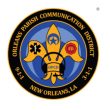FirstNet adoption increases by almost 50% during last two months, AT&T says
Public-safety adoption of FirstNet jumped almost 50% during the last two months amid initially favorable reviews of system performance during recovery efforts associated with Hurricane Florence and Hurricane Michael, according to AT&T officials.
More than 3,600 public-safety agencies—representing more than 250,000 subscriptions—have subscribed to FirstNet to date, AT&T Communications CEO John Donovan said today during the carrier’s quarterly earnings call. Key to this success has been the performance of the FirstNet system during critical response, he said.
“We are seeing, in real time, how we’re performing in times of emergency, with Hurricane Michael being the latest example.” Donovan said during the conference call, noting AT&T preparation for the storm and use of deployable assets in the affected areas. “Because of this effort, we were able to keep our first responders connected during and after the storm in many area. In fact, our network operated at 90%–and usually better—of normal performance in the areas affected by Hurricane Michael.
“One first responder went as far as to say, ‘When everything else was down, FirstNet was working.’ That’s high praise, and we’re humbled that we can play a part in helping the community recover from such a devastating story. That’s what FirstNet is all about.”
Chris Sambar, senior vice president, FirstNet at AT&T, expressed a similar sentiment.
“FirstNet is being purpose-built to favor the important work first responders do. This is challenging and time consuming. It’s also necessary,” Sambar said in a prepared statement issued yesterday. “Much work still needs to be done to make sure FirstNet is a solution that meets the needs of all first responders. But we’re proud of how FirstNet has been delivering for first responders and the communities they serve when help is most needed. And we’re honored to see public safety embrace their network.”
Doug Cofty, Colquitt Miller (Ga.) emergency services director, said he glad that his agency switched to FirstNet service before Hurricane Michael made landfall.
“We moved to the FirstNet system a few months before Hurricane Michael hit. And it was a no-brainer. Having the communications capabilities FirstNet provides was critical following the storm’s devastation,” Cofty said in a prepared statement. “Gaining that peace of mind around our communications meant we could focus on what mattered most—supporting our community.”
In addition to supporting massive efforts such as the multistate response to Hurricane Michael, a FirstNet deployable asset was used to provide needed coverage to a recent search-and-rescue effort conducted by the Yankton Sioux Tribe Police Department in a rural part of South Dakota.
“In situations like these, communication is critical, and time is of the essence,” Yankton Sioux Tribal Police Chief Chris Saunsoci said in a prepared statement. “Knowing the mission was focused in an area with limited coverage, we requested a FirstNet SatCOLT [satellite-connected cell on light truck] to boost our connectivity. Communications were in place within hours of our request, helping us carry out our operation.
“Serving on the State of South Dakota’s Public Safety Communications Council, I helped advise Governor Daugaard’s decision to approve the build out of the FirstNet network platform by AT&T. After benefiting from FirstNet in real-life situations, it’s a decision I’m proud to have supported for the South Dakota public-safety community.”
Donovan said that AT&T has completed about one-third of the deployment of infrastructure supporting operations on 700 MHz Band 14 spectrum—simultaneous with deployments of gear for the AWS-3 and WCS bands, as well as pre-5G measures—which puts AT&T “six months ahead of schedule” for the FirstNet deployment. AT&T has invested more than $2 billion in the FirstNet program to date, according to an AT&T slide.

















